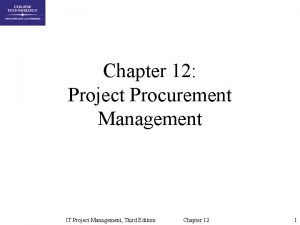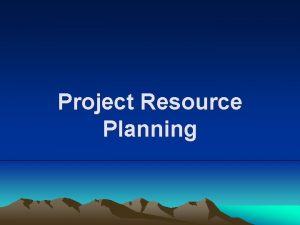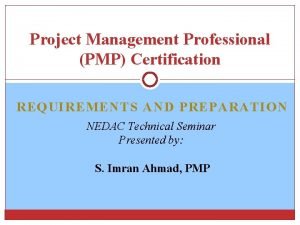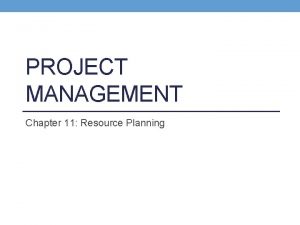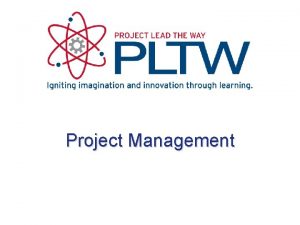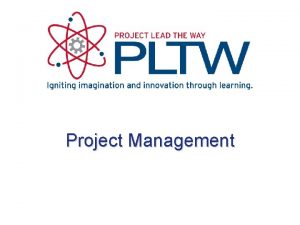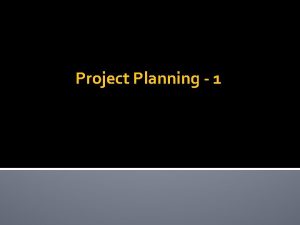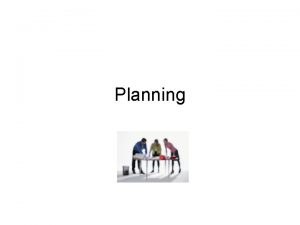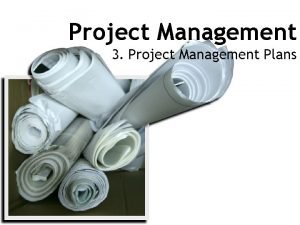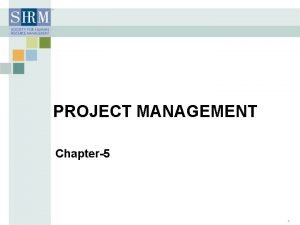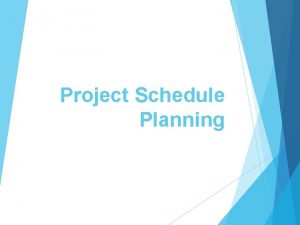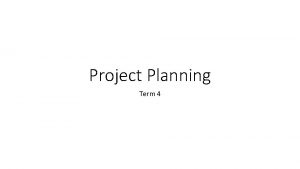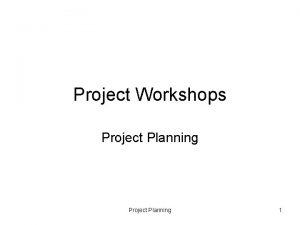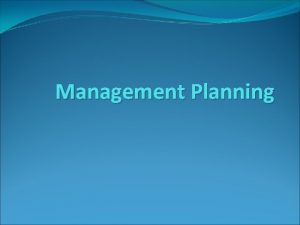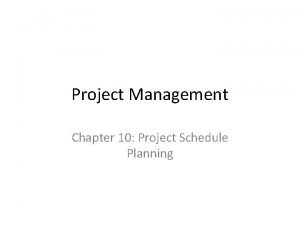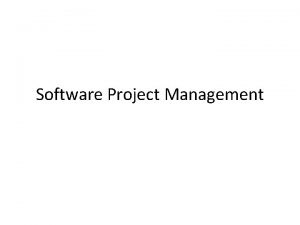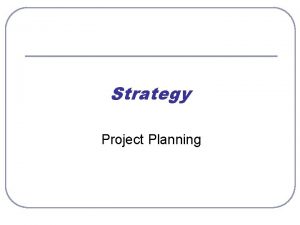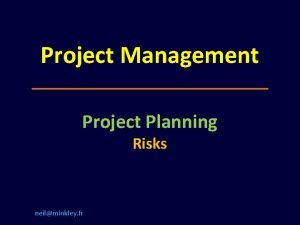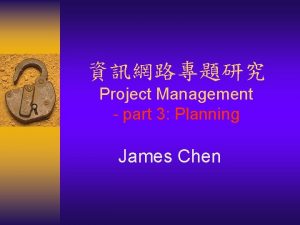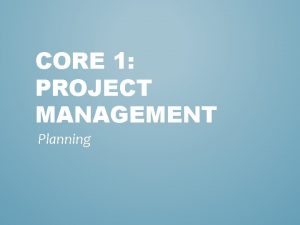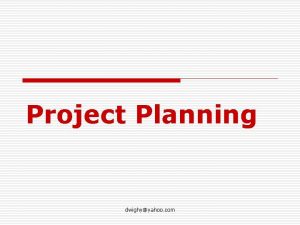Project Management 1 4 Planning a Project 1























- Slides: 23

Project Management 1

4. Planning a Project 1. Stakeholder Management 2. Project Scheduling 3. Budget Planning 4. Risk Management 2 2

Discussion • How useful were the stakeholder management tools? • Questions on the tools? • How did the team cooperation work? • Any intercultural differences? • How was your team organised? 3 3

Review Project Environment Project Structure Stakeholder Team Culture Objective Organisational Context Organisational Structure WBS 4 4

Project Scheduling 5

Learning Objectives After completing this chapter, you should be able to: 1. Be aware of different methods of project time planning 2. Understand how scheduling contributes to achieving project management objectives 3. Be able to apply common scheduling tools on your project 6

Project Scheduling & Planning Project Scheduling PMBo. K defines it as “an output of a schedule model that presents linked activities with planned dates, durations, milestones, and resources. ” Project Planning “The identification of the project objectives and the ordered activity necessary to complete the project including the identification of resource types and quantities required to carry out each activity or task. ”(PMBo. K) Source: PMBo. K. 7

Milestone Schedule Source: Horine (2013). 8

Ten Steps to Create a Schedule Source: Horine (2013). 9

Scheduling Methods Gantt Chart Network Diagrams • Critical Path Method (CPM) 10

Project Scheduling Terms • Project Network Diagram: any schematic display of the logical relationships of project activities • Path: a sequence of activities defined by the project network logic • Event: a point when an activity is either started or completed • Node: one of the defining points of a network; a junction point joined to some or all of the other dependency lines (paths) • Predecessors: those activities that must be completed prior to initiation of a later activity in the network • Successors: activities that cannot be started until previous activities have been completed, these activities follow predecessor tasks Source: Pinto (2015). 11

Network Diagram Exercise: Writing a Term Paper 1. Which activities are necessary when writing a term paper? 2. In which sequence/order do these activities take place? 12

Precedence Relationships Finish to Start The “from” activity, Task 1. 1, must finish before the “to” activity, Task 1. 2, can start Task 1. 1 Task 1. 2 13

Precedence Relationships Start to Start Task 1. 1 Tasks 1. 1 and 1. 2 may start at the same time, but the successor (1. 2) cannot start until the predecessor (1. 1) begins Task 1. 2 The direction of the arrow defines which task is the predecessor and which is the successor 14

Precedence Relationships Finish to Finish Task 1. 1 Tasks 1. 1 and 1. 2 may end at the same time, but the successor (1. 2) cannot finish until the predecessor (1. 1) finishes Task 1. 2 15

Precedence Relationships Start to Finish Task 1. 1 must start before Task 1. 2 can finish (seldom used) Task 1. 2 16

Serial Activities Serial activities are those that flow from one to the next, in sequence. 1. 1 Identify research Topic 1. 2 Literature search 1. 3 Write outline Source: Pinto (2015). 17

Network Diagram – Nonserial Sequential Logic 2. 1 Install library software 2. 2 Further Literature search 3. 1 Draft paper 1. 3 Write outline 1. 4 Write Abstract 1. 5 Feedback from supervisor 18

Concurrent Activities When the nature of the work allows for more than one activity to be accomplished at the same time, these activities are called concurrent, and parallel project paths are constructed through the network. 1. 3 Write outline 2. 1 2. 2 Install library software Further Literature search 1. 4 Write Abstract 3. 1 Draft paper 1. 5 Feedback from supervisor 19 Source: Pinto (2015). 19

Complete Activity Network 1. 1 Identify research Topic 1. 2 Literature search 1. 3 Write outline 2. 1 2. 2 Install library software Further Literature search 1. 4 Write Abstract 3. 1 Draft paper 1. 5 Feedback from supervisor 20

Quiz 1) A sequence of activities defined by the project network logic is a(n): a) b) c) d) Event Path Node Route 21

Homework 1. Search for other software/online tools for project scheduling. What are advantages and disadvantages? 2. Additional Reading: Caughron, J. J. , & Mumford, M. D. (2008). Project planning: The effects of using formal planning techniques on creative problem‐solving. Creativity and Innovation Management, 17(3), 204‐ 215. 22

References • Horine, Greg (2013): Absolute Beginner’s Guide to Project Management, Que Sams/Pearson Education, 3 rd ed. • Pinto, J. K. (2015): Project management. Achieving competitive advantage, Pearson Education, Harlow, Essex, 4 th ed. • Project Management Institute (2013): A Guide to the Project Management Body of Knowledge: PMBOK(R) Guide, Project Management Institute; 5 th ed. 23
 Importance of software project management
Importance of software project management Activity based approach in software project management
Activity based approach in software project management Solicitation planning example
Solicitation planning example Resource loading meaning
Resource loading meaning Pmp certification timeline
Pmp certification timeline Corporate strategy meaning
Corporate strategy meaning Resource planning definition in project management
Resource planning definition in project management Project planning and management lecture notes ppt
Project planning and management lecture notes ppt Strategic planning vs tactical planning
Strategic planning vs tactical planning Goal achievement matrix
Goal achievement matrix Role segmentation workforce planning
Role segmentation workforce planning Proactive planning and reactive planning
Proactive planning and reactive planning Perencanaan kapasitas dan agregat
Perencanaan kapasitas dan agregat Long term plan and short term plan
Long term plan and short term plan Language policy and planning slideshare
Language policy and planning slideshare List the strategic objectives of aggregate planning
List the strategic objectives of aggregate planning Examples of aggregate planning
Examples of aggregate planning The role of project management in achieving project success
The role of project management in achieving project success Modern process transitions in spm
Modern process transitions in spm Reasons for reducing project duration
Reasons for reducing project duration Introduction to project management kathy schwalbe
Introduction to project management kathy schwalbe What is strategic assessment in software project management
What is strategic assessment in software project management When conducting post project audits
When conducting post project audits Microsoft project agile
Microsoft project agile


